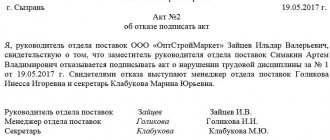A labor dispute commission is created in an organization from representatives of the employer and employees. By means of an order to create a labor dispute commission, the head of the organization secures its composition and determines its powers. Files in .DOC: Form of order on the creation of a commission on labor disputesSample order on the creation of a commission on labor disputes
Legal status of the commission on the Labor Code
The powers vested in the labor dispute commission are truly extensive, which makes it possible to compare it with a court (however, judicial bodies are government bodies and are of greater importance in the life of society).
The laws of the Russian Federation provide that the commission is vested with the powers to consider, separate and resolve disputes arising between employees and their superiors, as well as to make decisions based on the results of the analysis.
Controversial issues referred to resolution by the commission can only relate to labor functions, namely, they must arise from problems in the implementation of labor law norms. The group of such norms includes not only federal laws and laws of constituent entities of the Russian Federation, but also local acts of the enterprise, such as internal labor regulations and individual orders.
Labor disputes and the procedure for their resolution.
Regulations on CTS
Taking into account the most frequently encountered reasons for appeal and industry characteristics of enterprises, its preparation has certain specifics :
- It is mandatory to set out information about the procedure for forming the commission, the general provisions of its work, the assigned name and powers.
- A list of regulatory and legal acts, directives, and instructions used for decision-making is also indicated.
- One of the main components of the regulation is the definition of the competence of the commission. The basis for its formation, the rights and responsibilities of specific members of the CCC are outlined.
- The regulations determine the procedure for receiving applications from applicants and the methods and regulations for organizing meetings.
The procedure for making decisions on disputes by the CCC, as well as their implementation or appeal by the parties, is included in the list of procedural subtleties set out in the document.
Who can be the initiator
The following entities can initiate the formation of a CTS:
- employer,
- employees of the organization,
- trade union of workers,
- upon reaching agreement, the parties jointly.
The initiating party will have to formalize its decision to create a labor dispute commission in writing. This requirement is established by law, which means it is subject to mandatory fulfillment.
However, if the employer does not respond in any way to the initiative to create a commission by the employees of the enterprise, he will be brought to administrative and legal liability in accordance with Article 5.27 of the Code of Administrative Offenses.
Disputes considered by the commission
The Labor Dispute Commission has the right to resolve controversial issues only within the range of issues defined by law:
- inclusion and exclusion of clauses in the employment contract if one of the parties disagrees with them,
- disagreements based on issues of setting wages and cash payments for overtime work, etc.,
- bringing employees to disciplinary liability or removing it.
Watch the video. How to resolve a labor dispute without court:
Disputes that cannot be considered in the CCC
Any other issues other than those listed above are subject to judicial review.
In most cases, these include:
- change of job functions, as well as change of place of work within the same organization, but in different structural units,
- disagreement to hire a new person,
- resumption of the employee’s labor functions after his dismissal,
- cash payments due to forced absence,
- compensation payments arising due to the involuntary transfer of an employee to a position with reduced pay,
- failure by the employer to comply with the rules for processing personal data of the organization’s employees,
- disputes over claims by workers that they suffered moral damage because they were disadvantaged on the basis of gender, race and other characteristics.
Note! The competence of the commission cannot include disputes regarding property damage caused by an employee (damage to furniture, material assets of the organization, etc., theft by third parties due to the employee’s negligence).

Dismissal for violation of labor protection requirements.
How night hours are paid according to the Labor Code of the Russian Federation, read here.
Who has the right to a shortened working day according to the Labor Code of the Russian Federation, read the link: https://novocom.org/otvety-na-voprosy-chitatelej/kto-imeet-pravo-na-sokrashhennyj-rabochij-den-po-tk-rf .html
The procedure for creating a commission on labor disputes
Submitting an application
applications to the labor dispute commission free of charge in word format
To start the work of the labor dispute commission, an application must be submitted by the party with an interest in resolving the labor dispute. The law provides a prescribed form for documents of this type.
It should contain parts such as:
- information about the labor dispute commission and the person submitting the application (last name, first name, position and labor functions),
- data on the controversial issue outlining the facts of disagreement. The words need to be supported by references to labor law norms, as well as to local regulations,
- part of the petition stating the applicant’s demands,
- a list of documents provided by the party, as well as their copies,
- date of application, signature of the person with transcript,
Next, the application goes through a mandatory registration procedure in the organization’s journal, where next to the entered fact of acceptance of the application, the signature of an authorized member of the CCC is placed.
ATTENTION! Look at the completed sample application to the labor dispute commission:

Punishment of the employer for violation of labor laws.
Formation of the composition of the commission
The registration procedure is followed by the start of the work of the labor dispute commission, which must occur within ten days from the date of entry into the journal of the acceptance of the application.
Therefore, in theory, the same number of representatives can be present at a meeting. They are required to elect a chairman and a replacement. At least half of the members must be present on both disputing sides.
After employees provide confirmation to participate in the commission, the manager will be required to issue an order. Without its signing, it is impossible to hold a meeting, since it cannot be legal.
order on the creation of a commission to resolve labor disputes free in word format
The order is issued on the letterhead of a legal entity. If there is none, on regular sheets.
According to legal requirements, the document must contain:
- Business name,
- the start date of its work,
- locality,
- the basis for convening the CTS (due to the appeal of M.G. Kozlova, at the request of the trade union of the organization, etc.),
- data from representatives of the labor dispute commission outlining information about the chairman and secretary.
After drawing up the document, it should be signed by the general director of the legal entity where the commission meeting is held. A copy of the order must be presented to all employees for review.
ATTENTION! Look at the completed sample order for the creation of a commission for resolving labor disputes:

Certificate
In situations where the decision of the CCC was not executed or appealed within the prescribed period, the commission issues a special writ of execution to the applicant in whose favor the decision was made.
This certificate allows you to go to court to initiate enforcement proceedings within up to three months from the date of its issue.
What does the ID look like?:
- The document must necessarily contain information about the name of the CCC and the date of the decision on the case under consideration.
- Information about the issuance of the certificate is also entered (date, signatures of the chairman or secretary with a transcript), the data of the citizen on whose claim the dispute was initiated is stated, and information about the decision made is recorded (read about on whose initiative the commission is formed, read here).
- The document is certified by the seal of the commission.
Getting started: who should be present
The presence of the person who made the application is required for all meetings of the labor dispute commission.
However, the employee’s personal presence is not mandatory; he can:
- send a representative to the meeting,
- indicate in the application that he agrees to consider the case in his absence.
If a person does not attend meetings several times or more, the deliberative body adjourns the meeting. If he is absent again without good reason, the commission has the right to suspend its activities. The employee is not deprived of the opportunity to convene the CCC a second time on the same problem, but if he withdraws the application, he will not be able to initiate the convening of the commission. However, he will be able to apply to the courts to resolve the problem.
Attention! Our qualified lawyers will assist you free of charge and around the clock on any issues. Find out more here.
Basic rules for considering ITS
In most cases, the commission considers the submitted application in the presence of the employee who made his claims. If the applicant does not appear and does not submit a written request to consider the case without his participation, the CCC is obliged to postpone the meeting. If you fail to appear again, the case may be removed from consideration altogether. However, this does not deprive the person of the right to re-apply to the CCC on the same issue, unless, of course, the general 3-month period for filing a claim has expired.
The commission has the right to make decisions provided that the following are present at the meeting:
- at least 50% of the total number of members appointed by the employer;
- the same number of members on the employee side.
When considering a case, the CCC has the right to invite specialists who have special knowledge in various fields, as well as hear the testimony of summoned witnesses. If a fair and objective decision requires certain documentation that is at the disposal of the administration, the papers must be provided to the commission upon its request.
Note! The progress of the meeting is reflected in the minutes, which are signed by the chairman and his deputy. The document is also sealed.
Operating procedure
Consideration of labor disputes takes place during meetings. There can be a large number of these, and during each of them, representatives of the labor dispute commission are required to draw up minutes of the meeting according to the sample established by the organization.
The document must contain the time of the meeting, information about the attendance of participants (this group includes experts, specialists and witnesses who are invited by the commission or any of the parties). The minutes contain statements of participants, important situations occurring at the meeting, as well as submitted copies of documents, certificates and other evidence supporting the arguments of the parties.
In general, meetings held by a labor dispute commission are similar to court hearings.
Remember! The commission is required to have its own seal, and not use the one that the employer has.
Decision-making
Decisions are made in the labor dispute commission through secret voting, in which each member of the commission has one vote. The result is determined by a majority vote. If different opinions are equally important, a second discussion is held until a decision is made by a majority vote.
Based on the results of studying the problem situation, the CTS presents a solution by drawing up a document, which is drawn up in writing.
decisions of the labor dispute commission free of charge in word format
It must contain information about the case being considered on its merits, as well as:
- last name, first name, patronymic of the representatives of the labor dispute commission,
- information about witnesses,
- information about specialists,
- information about other participants involved in the process.
Each decision made must comply with the design rules established by law and be informative.
minutes of the meeting of the commission on labor disputes free in word format
Today, labor legislation contains instructions that the document must display information about:
- the name of the legal entity in which the consideration and resolution of the labor dispute takes place,
- surname, name and patronymic of the employee who initiated the convening of the commission, as well as information about his labor functions and specialty,
- the date of consideration of the dispute by the labor dispute commission,
- the circumstances of the issue under consideration,
- list of meeting participants,
- the result of the consideration with a full description of the merits of the case and the decision made in accordance with it. Actions must be accompanied by references to regulations,
- results of the voting.
The specified parts are required to be included in the decision of the labor dispute commission. Without them, the document will not have legal force.
Upon completion of its preparation, it is signed by the chairman of the CCC or his substitute, and also affixed a seal. Copies of documents are presented to the meeting participants for review within three days.
ATTENTION! Look at the completed sample minutes of the meeting of the labor dispute commission:
Deadlines for employees to apply
An employee has the right to apply to the CTS within three months. The countdown of this period begins from the moment the dispute arises. It is believed that within three months the conflict will be resolved naturally. If this does not happen, the employee must seek help from the CTS.
But, there are a couple of nuances here. If an employee decides to appeal to the commission because he was fired illegally, and this problem can be considered as a pre-trial issue, then he must immediately contact the CCC.
This action must be performed immediately so that later the court does not have questions about delaying the date of protest.
According to Article 386 of the Labor Code of the Russian Federation, an employee has the right to come to the commission three months from the date of violation of his rights. If an employee does not apply within three months for a good reason, then the deadline can be restored and the issue considered.
The period for reviewing the application by the commission is ten days. During this period, the application must be considered. If the commission refuses this, the employee will be provided with all the arguments.
If the commission accepts the application, the dispute must be resolved within one month. If the commission makes a decision that does not suit the employee, then he can go to court with the same statement.
After the CCC has made its decision regarding a labor dispute, the parties are given 10 days to challenge it. If it has not been appealed, within 3 days after the expiration of the specified period, the decision of the CCC is subject to execution (paragraph 1 of Article 389 of the Labor Code of the Russian Federation).
If the decision was not executed within the prescribed period and none of the parties transferred the dispute to court, the employee is entitled to apply to the CCC for a special certificate (paragraph 2 of the above norm). This document, by its legal nature, is executive, and, based on it, the bailiff is authorized to enforce the decision of the CCC. The deadline for submitting the said certificate to the bailiff is no more than 3 months from the date of its receipt.
However, if an employee missed the deadlines for applying for a certificate (within 1 month from the date of the decision of the CCC) and/or submitting it to the bailiff for execution, the CCC, if there are objective grounds, can restore the said deadlines.
IMPORTANT! The Labor Code of the Russian Federation does not contain regulations on the mandatory pre-trial settlement of disputes, therefore an employee whose rights have been violated can immediately apply for their protection to the court, bypassing the CCC. In addition, in case of disagreement with this decision, the employee may, within 10 days from the date of delivery of a copy of the decision, go to court to appeal it (clause 2 of PPVS No. 2).
So, the decision of the CCC is made through a secret vote of the commission members by a simple majority of votes. Although a unified/standard sample of such a document has not been approved, the law has requirements for the composition of the information included in it, in the absence of which the decision may be considered illegal.
Liquidation
It is possible to revoke a labor dispute commission only through a written statement from the participants in the process, on whose initiative it was created. If the employer or its representatives no longer wish to participate in the CTC, they issue an appropriate order. If any of the enterprise personnel does not want to participate, the issue is resolved at a general meeting.
It is possible to liquidate a labor dispute commission upon the final termination of the activities of a legal entity or upon a change in the management of the enterprise. The possibility of liquidation cannot be excluded if such a decision was made by a majority vote at a working meeting of employees.
Watch the video. Online inspection of the Russian Federation:
Members of the commission - who are they?
There is no universal list of participants, but any commission will have to include a labor protection specialist and a representative of the trade union (or other internal organizational structure of workers). We will also need a chairman. Usually this is someone from management (head of department, deputy manager). In some cases, the committee will have to include representatives of supervisory agencies.

The number of commission members must be odd. The minimum number is 3 people, the optimal number is 5-7. In the first paragraph of the order, the members of the commission are listed. First, the person’s position and departmental affiliation are indicated, and then the surname and initials.









